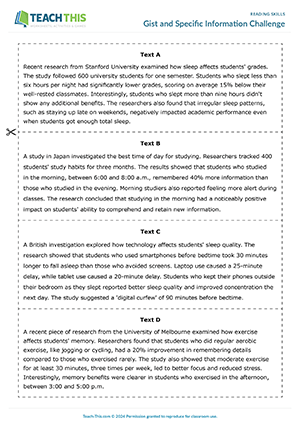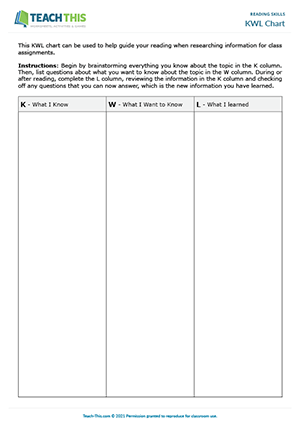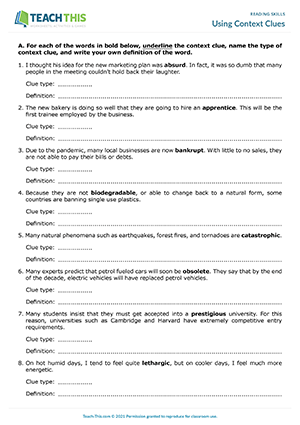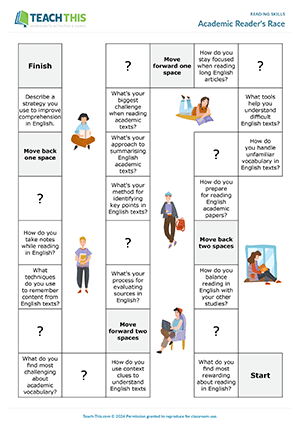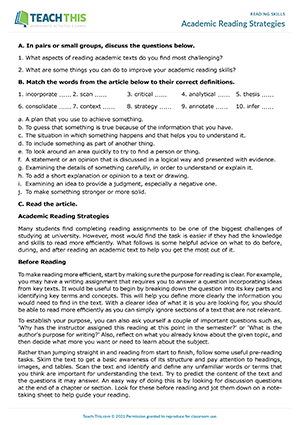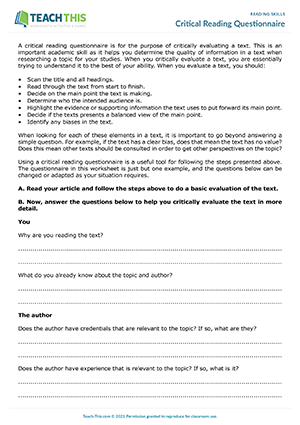In this informative reading skills worksheet, students learn and practice useful reading skills that include reading for gist, inferring meaning from context, understanding text organisation, and reading for details. First, students read about reading for gist and skim an article, reading the title, first paragraph and first sentence of each paragraph. Students then answer questions based on reading for gist. Next, students read about guessing the meaning of vocabulary from context. Students then look at words and answer questions about context clues and word forms. After that, students write the word or phrase that provides a clue to words from the article. Afterwards, students read about understanding text organisation and scan a text to locate reference words within the text and indicate the subject or idea to which they refer to. Students then scan to locate sentence connectors, writing the function of each sentence connector and describing the two ideas it connects. Finally, students read an introduction on reading for more detail and answer two multiple-choice questions.
Here is a fun academic reading skills game to help students practice reading for gist and specific information. First, teams discuss the difference between reading for gist and reading for specific information. Next, teams have one minute to read a short text for gist. Teams then get one more minute to identify the two key terms that relate to the main focus of their text, scoring one point for each correct term. After that, teams have five minutes to read for specific detail and answer comprehension questions. Finally, each team gives their answers to the questions, scoring two points for each correct answer, and one point for a partially correct answer. The team with the most points at the end of the game wins.
In this useful reading skills activity, students become familiar with KWL, an acronym for Know, Want-to-know, and Learned. It is an effective way to help students read with purpose. KWL is easy to use, and its function is to foster improvement in students' ability to read efficiently and to retain what they have learned as a result. The basic overall purpose of this worksheet is for students' responses and questions to guide and direct their reading. Students begin by brainstorming everything they know about the topic in the K column by responding to the 'What I Know' prompt. Next, students list questions on what they want to know about the topic in the W column by responding to the 'What I Want to Know' prompt. In the last step, students complete the L column by responding to the 'What I learned' prompt and review the K and W columns. As students record what they have learned, they review the K column to identify any misconceptions about the topic they might have held before reading. Students also review the questions in the W column, checking off any questions that they can now answer.
In this free context clues worksheet, students learn and practice how to use five common context clues to infer the meaning of unfamiliar words. To begin, students read an introduction that explains context clues and their importance. Students then read about five common context clue types and examine example sentences that demonstrate how each clue type works. Finally, students complete an exercise that requires them to infer the meaning of unfamiliar words. For each word, students underline the context clue surrounding the word, name the type of context clue and write their own definition of the word.
This engaging reading skills board game helps students review and reinforce their knowledge of skills and strategies that are critical for successful academic reading. Players take turns rolling the dice and moving their counter along the board. If a player lands on a 'question' square, they answer the question and talk about the reading skills topic for 30 seconds without stopping. If a player can't think of anything to say or stops talking before the 30 seconds are up, they go back two squares. If a player lands on a 'Question Mark' square, another student picks up a card and reads out the reading skills question along with three possible multiple-choice answers. The player then chooses an answer. If it's correct, the player stays on the square. If not, they move their counter back two squares. The first player to reach the finish wins the game.
This handy academic reading strategies worksheet helps to introduce strategies that help students become more effective readers. As a lead-in, students discuss two questions about academic reading. Students then match words from the article in the worksheet to their correct definitions. Next, students read the article about reading strategies and answer true, false, or not given questions, according to the information provided in the text. Finally, students answer a series of questions based on the article.
This comprehensive critical reading worksheet helps students become familiar with the steps required to critically evaluate a text for use in their studies by answering questions that help determine the appropriateness and usefulness of a text. Beforehand, choose a topic for the students to research and select three short articles on the topic of varying quality and relevance for students to critically evaluate. At least one of the articles should be highly suitable, and at least one should be clearly unsuitable. Students begin by reading about the purpose of a critical reading questionnaire. Next, students read one of the articles and follow the steps outlined to do a basic evaluation of the text. After that, students evaluate the text in more detail by completing the questionnaire. Students then repeat the process with the other two articles. Afterwards, students discuss which of the three articles they thought was the best and why and report their findings to the class. Finally, the class discusses the merits of each text and decides which are suitable and which are not for the topic chosen.
Latest Free
Resources
- Jigsaw Reading
Reading Exam Preparation (B1)
Date Added: 7th of March
- Writing Jeopardy
Writing Exam Preparation (B1)
Date Added: 6th of March
- Present Perfect Bingo
Present Perfect Yes No Questions (A2)
Date Added: 4th of March
- Count on Me!
Making Offers and Promises (A2)
Date Added: 11th of February
- It’s Carnival Time!
Cultural Celebrations (B1)
Date Added: 29th of January
Latest Member
Resources
- Shops and What They Sell
Shopping (B1)
Date Added: 12th of March
- Who has written this?
Present Perfect Yes No Questions (A2)
Date Added: 11th of March
- Business Greetings and Introductions
Networking (B2)
Date Added: 11th of March
- Have you done this?
Present Perfect Yes No Questions (A2)
Date Added: 7th of March
- True, False or Not Given
Reading Exam Preparation (B2)
Date Added: 7th of March





